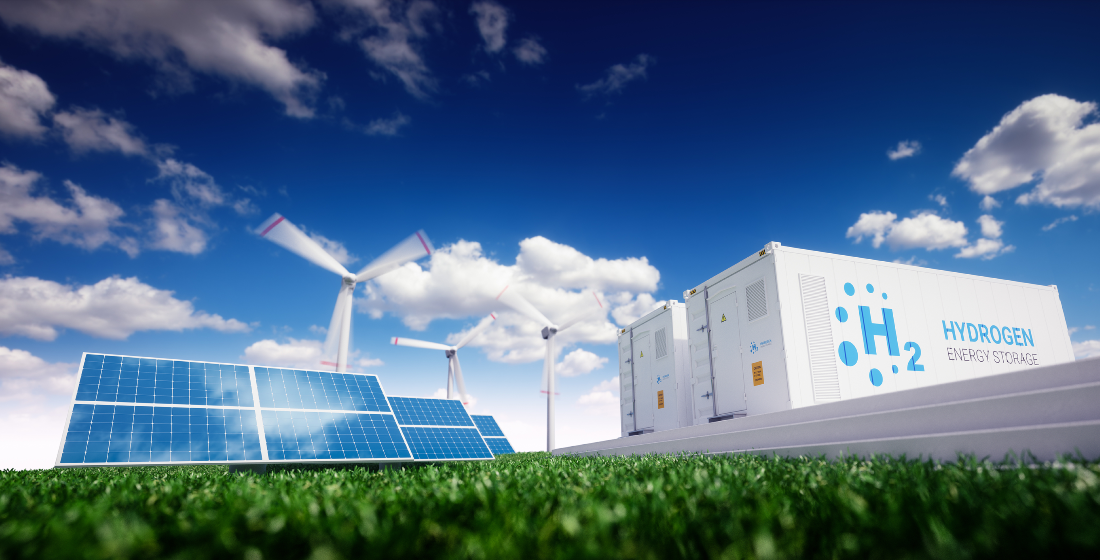How the EIB aims to power Europe’s green hydrogen revolution
The European Development Bank recently signed advisory agreements with two local hydrogen associations as it looks to finance the EU’s aim to increase hydrogen to 14% of the region’s energy mix by 2050.

The European Investment Bank (EIB) last month signed a couple of advisory agreements with hydrogen industry associations as it gears up to support the EU’s push to vastly expand the renewable power source in the region’s energy mix.
Brussels is backing hydrogen technology to play a crucial role in achieving a carbon neutral European economy by 2050. The current share of hydrogen in Europe’s energy mix is less than 2%, but the EU wants that to increase to 14% by mid-century. The European Hydrogen Strategy, part of the European Green Deal, aims to enable widespread use of hydrogen by 2050.
According to the strategy, green hydrogen will be produced on a “systemically relevant” scale between 2030 and 2050. To achieve that aim, investments in renewable or low-carbon hydrogen will need to increase substantially: the strategy anticipates that between €180 billion ($213 billion) and €470 billion will be required for production capacities in the EU by 2050.
“Green hydrogen presents an opportunity to decarbonise industrial processes, particularly in sectors where emission reduction is urgent but difficult to achieve,” said EIB president Werner Hoyer.
“Many European countries are actively supporting the development of hydrogen technologies. One of the main strengths of the European Investment Bank is that it combines advisory and technical support in the initial phases of a project with attractive forms of financing later on. This model is perfect for the development and deployment of new breakthrough technologies, including those based on the use of hydrogen.”
The EIB and Hydrogen Europe, an umbrella association representing European industry, research, and national and regional associations in the hydrogen and fuel cell sector, signed an agreement for consultancy services on 29 July. Under the agreement, the EU bank will provide financing advisory support for hydrogen projects introduced by Hydrogen Europe. The pair will also cooperate on market development initiatives and conduct joint market outreach.
Finally, the agreement will help to develop dedicated EIB financing products for green hydrogen. Alongside the European Commission, Hydrogen Europe is one of the three participants of the European Joint Undertaking on Hydrogen, a public-private partnership working to facilitate the market introduction of clean hydrogen technologies in Europe.
A few days earlier, the EIB also signed an advisory agreement with the Polish Cluster of Hydrogen Technologies to support the roll-out of clean hydrogen technologies in the country. The agreements follow on from similar advisory agreements with the Hydrogen Council, a global initiative of CEOs advocating for the accelerated deployment of hydrogen solutions, in December 2019; and one with France Hydrogène, the French association for hydrogen and fuel cells, in November 2020.
MDB hand-holding for a nascent market
There are various types of hydrogen, categorised by their production process and resultant greenhouse gas emissions. Green hydrogen (renewable hydrogen or clean hydrogen) is produced by the electrolysis of water using electricity from renewable sources and does not emit any greenhouse gases during its production. It is distinct from grey hydrogen, which is produced from methane and releases greenhouse gases into the atmosphere; and blue hydrogen, which captures those emissions and stores them underground to prevent them from exacerbating climate change. But obtaining green, zero-emission hydrogen is extremely costly, and development banks like the EIB will need to play an important initial funding role for the market to reach a position of commercial independence.
“We’ve worked closely with the European Commission on the advisory side to gather feedback from the market,” says François Gilles, Innovation Finance Advisory, EIB. “We’ve conducted an extensive investor consultation in the past year, consulting with 50 players in the hydrogen space to understand their outlooks and issues.
“The economics of the market; forthcoming regulation; offtake, operational and technology scale-up risks – these were issues high on the agendas of potential financiers. So we will look to support them with a suite of blended finance tools in order to de-risk the market for these players, at least until the market matures.”
The EIB could, for example, use those blended finance tools to come in at a junior level of the financing structure of a green hydrogen project, taking on an elevated risk profile, in order to make it possible for other lenders to come in at a more senior level with lower risk.
“We have a couple of products that we think are fit-for-purpose for hydrogen projects,” says Gilles. He points to the InnovFin Energy Demonstration Facility, designed to support commercial demonstration projects in the innovative energy space. There is also the Future Mobility Envelope under the EIB’s Connecting Europe Facility, designed to support the deployment of alternative mobility assets. “In both cases, those financing products allow the EIB to take on higher exposure than would normally be possible, thanks to the support of risk-sharing from the European Commission.”
Over the past eight years, the EU bank has provided over €2 billion in advisory and financial support to projects that use hydrogen technologies – as well as for projects that focus on scaling up deployment in the transport sector using new hydrogen fleets and related infrastructure. The bank is now focusing on supporting technologies such as electrolysers, catalysts and fuel cells; as well as financing large-scale hydrogen production, including electrolysis, carbon capture and storage and hydrogen stations.
“We’ve already started supporting the HyDeal Ambition Initiative in an advisory capacity, which is a large-scale solar-based electrolysis project in southern Europe,” says Gilles.
The HyDeal Ambition Initiative aims to deliver low-cost green hydrogen at scale – €1.5/kilogram by 2030 – made using electricity from solar. The production of green hydrogen generated by solar-driven electrolysis from the Iberian Peninsula will begin in 2022 with the goal of scaling capacity to 95 gigawatts (GW) of solar to drive 67GW of electrolysis capacity by 2030, enabling annual production of 3.6 million tonnes of green hydrogen. Offtakers in the energy, industrial and mobility sectors will be supplied with green hydrogen via the gas transmission and storage network. The first initiative is expected within a year in Spain, based on a portfolio of solar sites with a capacity of close to 10GW.
“We’re also supporting more downstream projects closer to the finish line – some only in the few tens of millions of euros in project costs – particularly in the areas of alternative mobility solutions or in fuel-cell technology” adds Gilles. “We’ve supported Elcogen in Estonia and the EverFuel project in Denmark, which had a higher-risk component and we helped finance with our blended finance solutions.”
The EIB provided Elcogen with a €12 million quasi-equity facility for further research and development, supported by the European Commission under the InnovFin programme. The financing enabled Elcogen to bring its fuel-cell technology to the market. Elcogen plans to manufacture approximately 2 million cells per year, accounting for an electrical capacity of 50 megawatts. The fuel cell technology that Elcogen has developed converts a range of fuels, mainly hydrogen and biogas, into electrical energy with a higher electrical efficiency compared to other commercially-available fuel cells.
The EIB also provided €20.7 million quasi-equity facility to Everfuel to support development
of hydrogen production and distribution infrastructure for Danish public transport. Everfuel will use hydrogen from existing and new sources to supply refuelling stations for buses and heavy-duty vehicles, initially in Denmark and later throughout Europe.
“The bank has around €1 billion of hydrogen projects in the pipeline: some are traditional production-style projects and others projects for integrating hydrogen into the manufacturing and mobility sectors. So there is a lot going on,” say Gilles.





